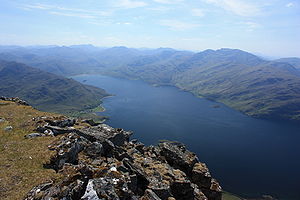
Loch Hourn (Scottish Gaelic : Loch Shubhairne) is a sea loch which separates the peninsulas of Glenelg to the north and Knoydart to the south, on the west coast of Scotland.

Loch Hourn (Scottish Gaelic : Loch Shubhairne) is a sea loch which separates the peninsulas of Glenelg to the north and Knoydart to the south, on the west coast of Scotland.
Loch Hourn runs inland from the Sound of Sleat, opposite the island of Skye, [1] for 22 km (c. 14 miles) to the head of the loch at Kinloch Hourn. At the entrance, its confluence with the Sound of Sleat, it is 5 km (3 miles) wide, becoming less than 2 km wide for much of its length, with successive narrows in the upper reaches and reducing to a 300-metre-wide basin at the head. [2]
Sometimes described as the most fjord-like of the sea lochs of northwest Scotland,[ citation needed ] it is steep-sided, with Beinn Sgritheall to the north and Ladhar Bheinn rising from the southern shore. The sea floor has been shaped by glaciation into five progressively deeper basins with relatively shallow sills; combined with the narrow and sheltered aspect of the loch and the high local rainfall, these result in an unusually wide variation of salinity and sea habitats over the length of the loch.
The loch is navigable by ships as far as Barisdale Bay. Small boats can reach Kinloch Hourn, but these upper reaches are dependent on tide and subject to strong currents. All of the loch is subject to fierce and erratic winds. There is no road access to most of the shoreline. Apart from a few isolated cottages, the only community is Arnisdale, with a population of around 30. Kinloch Hourn is 36 km (22 miles) on single track road from the A87 near Invergarry. [3]
Local economy is small scale. There is a fish farm near the mouth of the loch; a few local shell fishing boats; a few jobs dependent on the surrounding shooting estates and some local income from tourism.
A small passenger ferry/excursion boat which ran from Arnisdale to other parts of the loch, and provided access to the north shores of Knoydart, ceased business in 2011.
57°7′30″N5°35′37″W / 57.12500°N 5.59361°W

Knoydart is a peninsula in Lochaber, Highland, on the west coast of Scotland. Knoydart is sandwiched between Lochs Nevis and Hourn — often translated as "Loch Heaven" and "Loch Hell" respectively, although the somewhat poetic nature of these derivations is disputed. Forming the northern part of what is traditionally known as na Garbh-Chrìochan or "the Rough Bounds", because of its harsh terrain and remoteness, Knoydart is also referred to as "Britain's last wilderness". It is only accessible by boat, or by a 16-mile (26 km) walk through rough country, and the seven miles (11 km) of tarred road are not connected to the UK road system.
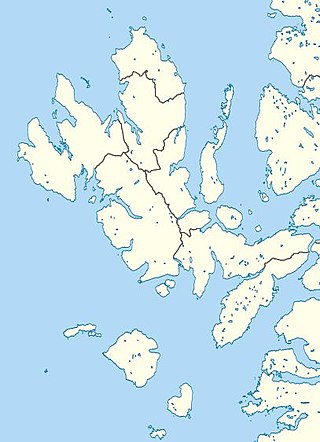
Sleat is a peninsula and civil parish on the island of Skye in the Highland council area of Scotland, known as "the garden of Skye". It is the home of the clan MacDonald of Sleat. The name comes from the Scottish Gaelic Slèite, which in turn comes from Old Norse sléttr, which well describes Sleat when considered in the surrounding context of the mainland, Skye and Rùm mountains that dominate the horizon all about Sleat.
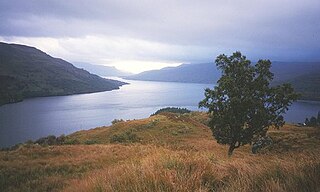
Loch Katrine is a freshwater loch in the Trossachs area of the Scottish Highlands, east of Loch Lomond, within the historic county and registration county of Perthshire and the contemporary district of Stirling. The loch is about 8 miles (13 km) long and 1 mile (1.6 km) wide at its widest point, and runs the length of Strath Gartney. It is within the drainage basins of the River Teith and River Forth.
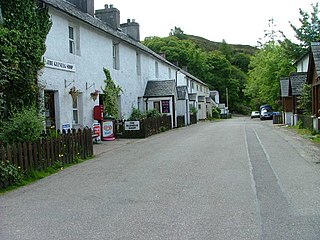
Glenelg is a scattered community area and civil parish in the Lochalsh area of Highland in western Scotland.

Loch Ryan is a Scottish sea loch that acts as an important natural harbour for shipping, providing calm waters for ferries operating between Scotland and Northern Ireland. The town of Stranraer is the largest settlement on its shores, with ferries to and from Northern Ireland operating from Cairnryan further north on the loch.

Kinloch Rannoch is a village in Perth and Kinross, Scotland, at the eastern end of Loch Rannoch, 18 miles (29 km) west of Pitlochry, on the banks of the River Tummel. The village is a tourist and outdoor pursuits centre. It has a small population and is fairly remote.

Corran is a hamlet on the northern shore of Loch Hourn, in Lochalsh in Inverness-shire in the Highlands of Scotland. It is situated at the foot of Glen Arnisdale, where the River Arnisdale flows past into Loch Hourn.

Arnisdale is a hamlet in the historic county of Inverness-shire in the local authority area of Highlands of Scotland. It lies on the north shore of Loch Hourn, around 10 miles down a single-track road from Glenelg. It has a permanent population of around 30 and several holiday cottages. At the end of the community is a large white-painted hunting lodge called Arnisdale House, built by architects Robert John Macbeth & Alexander Ross in 1898–1916. The house was built for Valentine Fleming of the banking family, who was killed in action in World War I, a year after the house was completed.

Beinn Sgritheall or Beinn an Sgrithill, also anglicized Ben Sgriol, is the highest mountain on the Glenelg peninsula in the Northwest Highlands of Scotland. It is a Munro with a height of 974 metres (3,196 ft). The main approach is via Arnisdale on the shores of Loch Hourn or via Gleann Beag to the north, with its well-known brochs. The view from the summit was described by Sir Hugh Munro, a founder member of the Scottish Mountaineering Club, as "perhaps the most beautiful I have seen in Scotland".

Loch Nevis is a sea loch in Lochaber on the west coast of Scotland.
The Rough Bounds, in the Scottish Highlands, is the area of West Inverness-shire bounded by Loch Hourn, Loch Shiel, and Loch Moidart, consisting of the districts of Knoydart, North Morar, Arisaig and Moidart. The area is famous for its wildness and inaccessibility and remains very sparsely populated.

Loch Alsh is a sea inlet between the isle of Skye in the Inner Hebrides and the Northwest Highlands of Scotland. The name is also used to describe the surrounding country and the feudal holdings around the loch. The area is rich in history, and is increasingly popular with tourists.

Drumfearn is a small crofting township, lying at the head of the Sleat peninsula, at the head of Loch Eishort, on the isle of Skye in the Highalnds of Scotland and is in the Scottish council area of Highland.

Duirinish is a peninsula and civil parish on the island of Skye in Scotland. It is situated in the north west between Loch Dunvegan and Loch Bracadale.
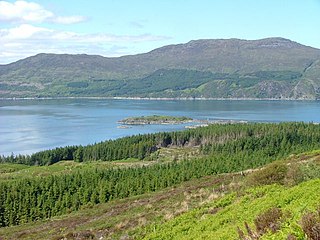
The Sound of Sleat is a narrow sea channel off the western coast of Scotland. It divides the Sleat peninsula on the south-east side of the Isle of Skye from Morar, Knoydart and Glenelg on the Scottish mainland.
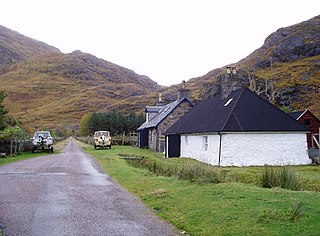
Kinloch Hourn is a small settlement at the end of Loch Hourn, in the West Highlands of Scotland. The name comes from the Gaelic, Ceann Loch Shubhairne, for "the head of Loch Hourn". Kinloch Hourn is at the end of 35 km of single-track road, which runs west from a junction with the A87 beside Loch Garry.

Loch Scridain is a 15-kilometre-long (9-mile) sea loch, with a west-south west aspect, on the western, or Atlantic coastline of the Isle of Mull, in the Inner Hebrides, Argyll and Bute, Scotland.

The Kyle of Tongue is a shallow sea loch in northwest Highland, Scotland, in the western part of Sutherland. Featuring a rocky coastline, its mouth is formed at Tongue Bay. The community of Tongue is situated on the Kyle's eastern shore and the loch is crossed by the Kyle of Tongue Bridge and Causeway.
Loch na Dal is a sea loch on the Sleat Peninsula on the Isle of Skye in the Inner Hebrides of Scotland. Kinloch Lodge, a hotel, is located on its northern shore and the A851 road runs along its southern shore. Although the meaning of the name is obscure in the current spelling, in the Blaeu Atlas of Scotland, 1654, the loch is listed as "Loch na Dallach". This could be "The Loch of the Delay" or "The Loch of the Meeting" or "The Loch of the Meadow". The later reading is possibly more likely, as a long river delta borders Abhainn Ceann-Locha as it enters the north end of Loch na Dal, and this piece of land is green and flat enough that it was at one time used as a football pitch.

Sandaig Bay is a coastal embayment, on a chord of 2.04 kilometres, on a 194° orientation, located on the northwestern end of the sea loch, Loch Nevis, facing the Sound of Sleat. The bay is within the western end of the Knoydart peninsula, in the Lochaber district in the historical county of Inverness-shire on the north west coast of Scotland.